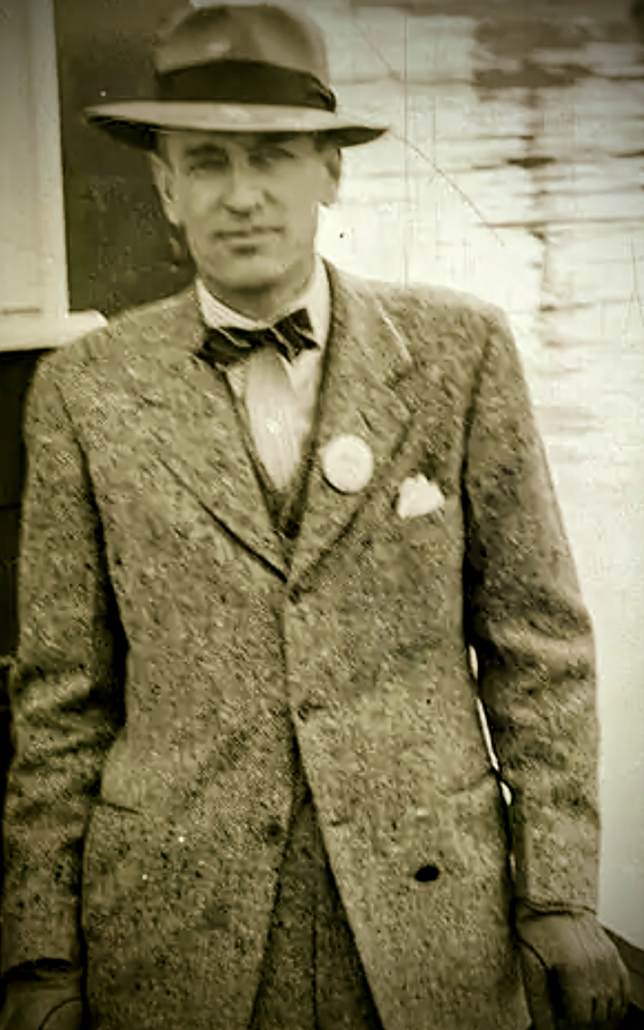An odd dock
By Jed Jaworski
Current Contributor
In the quiet backwaters of Betsie Lake, just east of downtown Frankfort, lie the hulking remains of two great ships: the Tampico and Adrian Iselin, their stories forgotten to the passage of time. These ships had traveled the globe, served during the great world wars, protected life and property, only to finally rest—nearly unnoticed—here in the harbor for a half-century. They lie as a silent testament to a time when Frankfort and Elberta were bustling commercial ports with near-constant arrivals and departures of large ships that dwarfed even the downtown buildings.
First came the beautiful sailing vessels in the 1850s with their towering masts, whose picturesque sails could be seen unfurled as the ships would crowd the harbor to refuge from a storm and dry their sails after. With only the wind, they carried goods for the growing northern towns and brought many local raw materials—including lumber, fish, and produce—to the fast-growing cities elsewhere along the coastline.
Then, beginning in the 1890s, a fleet of modern car ferries—employed by the railroad companies—carried passengers, automobiles, and entire freight trains across Lake Michigan from Elberta. During the same era, gleaming white passenger steamships also brought throngs of people from afar to resorts in the area, while steam freight vessels and fishing fleets continued to keep the wheels of commerce turning.
In 1930, E.R. “Duke” Luedtke founded the Luedtke Marine Engineering Company in Frankfort, making it homeport to a diverse array of tug boats, derricks, and scows that supported that industry.

Altogether, it was a bustling commercial waterfront—the whistles of ships and trains echoed beyond the towering forested hills that surrounded the harbor and provided for its snug, picturesque appeal.
However, with changing times and the loss of the car ferries in 1982, commercial marine commerce soon declined in this area, save for the comings and goings of the Luedtke fleet.
The success of Duke Luedtke’s enterprise resulted in the need for more space than their downtown Frankfort location could provide. With the steadfast determination and innovation for which he was recognized, Luedtke’s company developed a plan to expand into a shallow and undeveloped corner of the harbor that had previously been used as a smoldering municipal landfill. Approvals were gained from the U.S. Army Corps of Engineers to cap the landfill and dredge a channel and basin to a project depth of 10 feet, which would allow Luedtke’s fleet access to an otherwise inaccessible area of the harbor.

A marsh and dump do not make a good dock, though, so an improvement plan was developed that interestingly would alter the fate of two ships, the Tampico and Adrian Iselin, saving them from the torches of scrappers who soon threatened upon them.
The steamer Tampico had been built at the Craig Shipbuilding Company in Toledo, Ohio, in 1900. Nearly a football field in length and built of riveted steel, it was a large and modern vessel for its day. The ship was owned and operated by the Globe and Pacific Northwest Steamship Company of Seattle, Washington, and ran on the Pacific Ocean between Hawaii and the northwest coast of the North American continent.
At midnight on May 18, 1911, the Tampico sank at anchor, despite the efforts of the tug Lumberman and fireboat Snoqualmie to keep it afloat. It was soon raised and put back in service, however.
In 1917, the Tampico was sold to the Crowell & Thurlow Company and dispatched to the Atlantic Ocean during the First World War. In 1922, it returned to service on the Great Lakes, where it had been built.
Later, as the conflict worsened during World War II this time, the Tampico was outfitted once again for ocean duty and sold to England’s Ministry of War when U.S. President Franklin D. Roosevelt essentially side-stepped Congress’s Neutrality Acts, which had previously prohibited the export of “arms, ammunition, and implements of war,” as well as foreign lending, in an attempt to keep the United States out of what had begun as a European conflict. By October 1941, however, the United States had committed itself to aiding the Allies through a program called “Lend-Lease,”* and thus the Tampico was dispatched over the Atlantic for a second time.
In 1946, after the war had ended, the Tampico came home again to the Great Lakes and sailed under the Nicholson Transit Company flag after a significant refit as a self-unloader. Then, in the early 1960s, the Tampico was retired and stripped for conversion to a barge.

Meanwhile, the Adrian Iselin was built at the Detroit Shipbuilding Company in 1914. At 244 feet long and 2,072 gross tons, it was also built of riveted steel and powered by two Scotch fire tube boilers and a triple expansion steam engine of 1,000 horsepower. It had a full life trading on the Great Lakes, the St. Lawrence River, and the Atlantic seaboard.
The Adrian Iselin was acquired by the Nicholson Transit Company in 1940. In 1961, it was sold to a Chicago scrap broker and laid to rest beside the aged Tampico at the foot of Riopelle Street on the Detroit River. There the two ships languished for three years, until being purchased by the Luedtke Engineering Company for a very bold plan.
The Wisconsin-Michigan Power Company wanted to construct a new nuclear power plant south of Kewaunee, Wisconsin, in 1967. They hired the Luedtke Marine Engineering Company to build and install huge cooling water intake pipes—14 feet in diameter and 1,750 feet long—out into Lake Michigan, as well as other infrastructure.
The site location was many miles from a safe harbor, which would leave the Luedtke workers, tugs, and equipment exposed to the sudden dangers of Lake Michigan weather. To overcome this formidable threat, Luedtke purchased four aged vessels to intentionally sink in a configuration, so as to provide a temporary safe harbor at the worksite—the steamships Tampico, Adrian Iselin, Alfred E. Krupp, and Saskatoon were purchased and towed to the worksite.
The brilliant plan had its risks, though—primary of which was that the ships could break apart while sitting on the lake bottom, making for a costly recovery when the job was finished.

The four ships were sunk according to plan, creating a horseshoe-shaped harbor protecting the job site. Moreover, the Krupp was still in good enough condition—with a functioning power plant and cabins—that it provided valued accommodations for Luedtke’s workers and was “lit up like a Christmas tree at night,” according to former employees.
When the work was completed in 1973, the four ships were raised without incident, despite five years having passed. The Krupp provided shelter for work at two subsequent job sites; the Saskatoon was towed to Kewaunee, Wisconsin, and scrapped.
But Luedtke Engineering had another plan for the Tampico and Adrian Iselin: the ships would be towed to Frankfort, brought up the newly dredged channel, and sunk perpendicular to shore at the former municipal landfill site, thus creating two much needed 250-foot steel docks for the company’s fleet—remember that this was a marshland, so building a set of docks from scratch would have been costly and difficult.

Today, nearly 50 years later, these two ships—which have seen such long, well-traveled, and storied lives—rest their bones in Betsie Lake, and yet they still provide revered service to the Luedtke Engineering Company, which now itself is the last commercial marine enterprise hailing from the Frankfort harbor.
So, the next time that you are paddling the harbor or looking down upon it from Google Earth, give a nod to these two old survivors from another century—their untold stories and the decades of service they provided.
*During World War II, the United States had begun to provide significant military supplies and other assistance to the Allies in September 1940, even though the United States did not enter the war until December 1941—much of this aid flowed to the United Kingdom and other nations already at war with Germany and Japan through an innovative program known as Lend-Lease, in which the United States would “lend” the supplies to the British and other Allies, deferring payment on the “lease,” and those ships were returned after the war.
Featured Photo Caption: Tampico, sunk at Pacific coal dock on May 18, 1911. Photo courtesy of the University of Washington libraries.





Nicely written piece of local insight, thank you!
Thank you for the wonderful story. My grandfather sailed on the Adrian Iselin.
My father and father-in-law both sailed on the Iselin back in the 30’s. Great to find where it went. Thanks